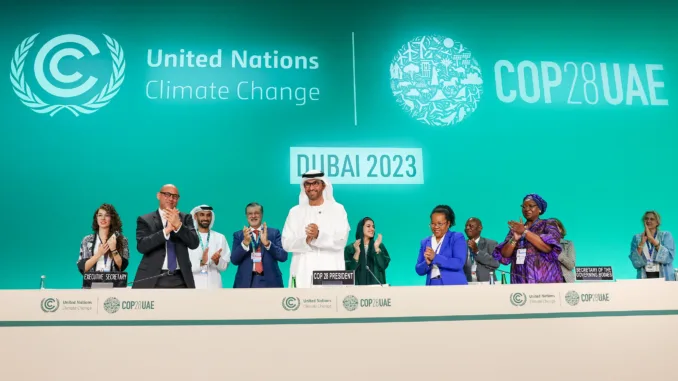
Internationalist class struggle against the bankruptcy of green extractivism
by Marc Bonhomme
One of the tasks of COP28, which kicks off on November 30 in Dubai, United Arab Emirates [UAE], will be to take stock of national commitments made at the Paris COP in 2015, which, according to the UN, does not look promising. “The world is on track for a ‘hellish’ 3C of global heating, the UN has warned before the crucial COP28 climate summit that begins next week in the United Arab Emirates.” (Damian Carrington, World facing ‘hellish’ 3C of climate heating, UN warns before Cop28, The Guardian, 20/11/23). Should we be surprised? “ADNOC [the national oil company at the heart of the UAE under the COP28 president] has the most ambitious expansion plans of any company in the world against the net-zero target for reducing net greenhouse gas emissions. […] the UAE’s state-run oil and gas fields are flaring gas virtually every day, despite having committed 20 years ago to a systematic zero flaring policy.” (Damien Carrington, World facing ‘hellish’ 3C of climate heating, UN warns before Cop28, Down to Earth, The Guardian, 23/11/23).
“At the current rate of GHG emissions, breaching the 1.5°C limit is almost inevitable. “There is a relatively small amount of allowable carbon emissions – known as the “carbon budget” – remaining if global warming is to be limited to 1.5C […] As Carbon Brief’s coverage of the UN Environment Programme emissions gap report shows, as of the start of 2023, the remaining carbon budget for having a 50% chance of keeping temperatures at 1.5C was only around 250bn tonnes of CO2 (GtCO2), which is roughly six years of current emissions. (DeBriefed, Carbon Brief, 24/11/23) :
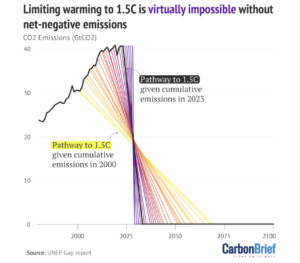
Argumentative proof of the failure of the best green capitalism without capture and sequestration
This is also the occasion when some of the major climate NGOs publish their own assessments of the state of play. The pessimism of the State of Climate Action’s fourth annual report 2023 is indeed systematic except for sales of electric vehicles… themselves problematic as a pillar of the new extractivism of all-electricity. Let’s not mince words. The report’s findings reflect the irretrievable bankruptcy of the best capitalist reformism consistent with the IPCC targets and without the popular spin with the big boys of CO2 capture and sequestration:
This year’s State of Climate Action finds that progress made in closing the global gap in climate action remains woefully inadequate — 41 of 42 indicators assessed are not on track to achieve their 2030 targets. Progress for more than half of these indicators remains well off track, such that recent efforts must accelerate at least twofold this decade. Worse still, another six indicators are heading in the wrong direction entirely.
Within this set of laggards, efforts to end public financing for fossil fuels, dramatically reduce deforestation and expand carbon pricing systems experienced the most significant setbacks to progress in a single year, relative to recent trends. In 2021, for example, public financing for fossil fuels increased sharply, with government subsidies, specifically, nearly doubling from 2020 to reach the highest levels seen in almost a decade. And in 2022, deforestation increased slightly to 5.8 million hectares (Mha) worldwide, losing an area of forests greater than the size of Croatia in a single year.
But amid such bad news, several bright spots underscore the possibility of rapid change. Over the past five years, the share of electric vehicles in passenger car sales has grown exponentially at an average annual rate of 65% — up from 1.6% of sales in 2018 to 10% of sales in 2022. For the first time in this report series, such progress puts this indicator on track for 2030. Global efforts are heading in the right direction at a promising, albeit still insufficient, pace for another six indicators, and with the right support, some could soon experience exponential changes. And among all indicators heading in the right direction, those focused on increasing mandatory corporate climate risk disclosure, sales of electric trucks and the share of EVs in the passenger car fleet saw the most significant gains in a single year, relative to recent trends.
Nonetheless, a considerable acceleration of efforts is needed in all sectors to be on track by 2030. For example, the world needs to
- Dramatically increase growth in solar and wind power. The share of these two technologies in electricity generation has grown by an annual average of 14 percent in recent years, but this needs to reach 24 percent to get on track for 2030.
- Phase out coal in electricity generation seven times faster than current rates. This is equivalent to retiring roughly 240 average-sized coal-fired power plants each year through 2030. Though continued build-out of coal-fired power will increase the number of plants that need to be shuttered in the coming years.
- Expand the coverage of rapid transit infrastructure six times faster. This is equivalent to constructing public transit systems roughly three times the size of New York City’s network of subway rails, bus lanes and light-rail tracks each year throughout this decade.
- The annual rate of deforestation — equivalent to deforesting 15 football (soccer) fields per minute in 2022 — needs to be reduced four times faster over this decade.
- Shift to healthier, more sustainable diets eight times faster by lowering per capita consumption of meat from cows, goats and sheep to approximately two servings per week or less across high-consuming regions (the Americas, Europe and Oceania) by 2030. This shift does not require reducing consumption for populations who already consume below this target level, especially in low-income countries where modest increases in consumption can boost nutrition.
It’s a pity that these fervent reformists of capitalism have fallen into the trap of electric vehicles. These, along with the proliferation of renewable energies chasing growth, are at the heart of the proliferation of open-pit mines and guarantee the continuation of energy-hungry urban sprawl. Fortunately, some experts are beginning to sound the alarm (Valérie Simard, Miracle ou mirage, la voiture électrique ?, La Presse, 29/10/23). The journalist criticizes the author of the book for failing to consider Quebec’s hydroelectric specificity. Quebec, along with a few other Canadian provinces or US states and countries such as Norway, Brazil and New Zealand, is the exception that proves the global rule: fossil fuels predominate even in electricity generation, and not only in overall energy consumption, where they account for some 80%, mainly due to transport. For electricity generation alone, these fuels currently account for 60% of the global total, of which 35% is coal, to which must be added 10% for nuclear power:
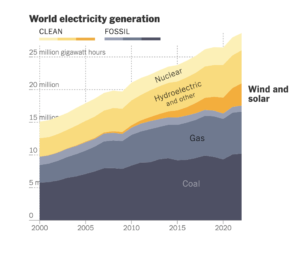
(The missing category is oil)
Nadja Popovich, How Electricity Is Changing Around the World, New York Times, 20/11/23
Reality belies the U.S.’s pretentious boast of clean electricity by 2035 (The Economist, Joe Biden’s climate-friendly energy revolution, 20/02/21), while forgetting nuclear power, and even so-called clean natural gas, which is essentially methane and leaks everywhere (Équiterre, Trois mythes sur le gaz naturel, 31/03/23) whose contribution remains lower than that of coal. The New York Times analysis gives pride of place to the countries of old imperialism, for which fossil energies producing electricity are decreasing while for the others, in particular China and India but also Indonesia and Mexico, they are increasing. This crude observation forgets, firstly, that the former have exported to the latter their dirty super-exploitative manufacturing production, the products of which are then imported, and secondly, that the latter claim the right, even if it’s wrongly and ultimately to the detriment of their people, to imitate the same type of consumerist growth as the former. As for the good news “on increasing mandatory corporate climate risk disclosure”, we are stunned by this greenwashing, denounced even by the United Nations (The Economist, The UN takes on corporate greenwashing, 10/11/22).
The cynical joviality of capture-sequestration and geo-engineering by the world’s great and good
This cold fact does not prevent technophiles from jovializing (David Gelles, Joy in action, Climate Forward – New York Times, 21/11/23) nor the world’s leading decision-makers to rely again and again on annual COPs, which always result in commitments that lead nowhere. Once again, for COP28, optimism is the order of the day. “The first is the task of cracking down on emissions of methane, an overlooked greenhouse gas (GHG). The second is the need to fill massive shortfalls in climate finance. And the third is an ideological battle over how and how fast to end the use of fossil fuels. The outlook for meaningful progress can be summed up as good, bad and ugly, respectively”. (The Economist, Three climate fights will dominate COP28, 16/11/23). Natural gas is touted as a transitional energy, despite the fact that the growing portion of natural gas produced by fracking technology emits more methane. “The scale of methane leakage associated with hydraulic fracturing is uncertain, and there is some evidence that leakage may cancel out any greenhouse gas emissions benefit of natural gas relative to other fossil fuels” (Wikipedia, Fracking, seen on 25/11/23). To save face, the “loss and damage” fund decided in extremis at COP27 will be topped up at the very least. “[T]he goal of developed country Parties to mobilize jointly USD 100 billion per year by 2020 has not yet been met” (United Nations, COP27 Reaches Breakthrough Agreement on New “Loss and Damage” Fund for Vulnerable Countries, 21/11/22) even though this target was set in 2010.
As for committing to a “phase out” rather than a “phase down” of hydrocarbons, resistance will be more than strong, despite the growing popularity of CO2 capture and sequestration technologies, which have created the catch-all concept of “abated” hydrocarbons. (The Economist – Special Report, Carbon-dioxide removal — The new economy net zero needs, 25/11/23), and why not on geoengineering to block solar radiation? (The Economist, Solar geoengineering is becoming a respectable idea, 22/11/23). This old-fashioned revival with a modern twist would take place under the aegis of improved and reinvigorated carbon markets, replacing the “offsets” that have now been denounced and rejected. (Euronews.green, Community conflict and vague predictions: The five biggest reasons carbon offsetting schemes fail, 1/10/23) by equally problematic “removals” monetizing “nature-based” solutions, i.e. the natural capture of CO2 like the growth of a forest. Even The Economist’s dossier admits that all these technologies are monetary and spatial Gargantua enhanced by a healthy dose of technological science fiction. Let’s add an ubiquitous dimension. For example, The Economist reports that U.S.-based oil company Occidental has bought out a Canadian company at the forefront of the latest trendy technology – direct air capture to extract CO2 – to inject it into those dying oil fields in Texas… to extract more oil. How cynical.
Distinguish between the responsibility of the 1% and the 10%, and then separate the 40% from the 50%.
What can we do to avoid the dead-end path of all-electricity superimposed on a slow fossil-fuel decline over an infinite horizon to make the most of gas and oil reserves, including those yet to be discovered, which requires ruinous and highly risky geo-engineering to avoid cooking the earth? The ecosocialist school of thought recommends that, before plunging headlong into renewable energy production that chases growth like a dog chasing its tail, we first drastically reduce per capita energy consumption, through energy sobriety and efficiency, without in any way reducing general well-being, which should not be confused with standard of living understood as a level of consumption. To be successful, this strategy has both a redistributive and a lifestyle revolutionary side, both of which require a revolution in social and political relations.
A very recent report by Oxfam and the Stockholm Environment Institute establishes the existence of a “great carbone divide”: “The richest 1% of humanity is responsible for more carbon emissions than the poorest 66% […] The report shows that in 2019 – the most recent year for which there is comprehensive data – high-income countries (mostly in the global north) were responsible for 40% of global consumption-based CO2 emissions, while the contribution from low-income countries (mostly in the global south) was a negligible 0.4%. […] A less discussed but faster-growing problem is inequality within countries. Billionaires are still overwhelmingly white, male and based in the US and Europe, but members of this influential class of super-rich can increasingly be found in other parts of the world. Millionaires are even more dispersed.” (Jonathan Watts, Richest 1% account for more carbon emissions than poorest 66%, report says, The Guardian, 20/11/23).
Nor is it just a problem of the super-rich, the 1%. “The richest 10% of people in many countries cause up to 40 times more climate-heating carbon emissions than the poorest 10% of their fellow citizens […] The world’s richest 10% encompasses most of the middle classes in developed countries – anyone paid more than about $40,000 (£32,000) a year. The lavish lifestyles of the very rich – the 1% – attract attention. But the 10% are responsible for half of all global emissions, making them key to ending the climate crisis. […] When climate negotiations began in the 1990s, most of the inequality in people’s carbon emissions was between rich and poor nations. Three decades on, the situation has reversed. Now, most of the inequality in emissions between the rich and poor exists within individual countries. […] Carbon inequality between countries accounted for two-thirds of all carbon inequality in 1990, but now two-thirds of carbon inequality occurs within nations.”
“This is because emissions in rapidly developing nations, such as China, have approached those in rich nations in recent decades, narrowing the difference between nations. The other key factor, […], was rising income inequality, particularly in the global south. […] Globally, the top 10% by income totals 770 million people, with almost two-thirds in high-income countries”. To be more precise, “[t]ransport, especially car use, is a major factor in the sky-high emissions of the richest 10%, with these emissions 20-40 times higher than the transport emissions of the poorest 10% in the countries analysed. In the US and Canada, road transport makes up about a third of the footprint of the top 10%. The transport emissions of the richest 10% are the same as the transport footprint of the bottom 70% of the population in those countries. Another major factor is the emissions embodied in the goods that people buy, such as furniture and electronics. These are 20-50 times higher for the richest 10%, and make up about a third of emissions in most countries” (Damian Carrington, Revealed: the huge climate impact of the middle classes, The Guardian, 20/11/23).
“So extreme is inequality that the lowest-earning 50% of the world population – 4 billion people – account for as little as 12% of total emissions.” Where do most of them live? “Climate modelling from 2020 suggests that within half a century about 30% of the world’s projected population – unless they are forced to move – will live in places with an average temperature above 29C. This is unbearably hot. Currently, no more than 1% of Earth’s land surface is this hot, and those are mainly uninhabited parts of the Sahara. […] Even if the lowest-earning third of the global population – more than 2.6 billion people – were to raise themselves above the $3.2-a-day poverty line, it would increase total emissions by a mere 5% – that is, one-third of the emissions of the richest 1%.” This situation reflects “the triple inequality that defines the climate global equation: the disparity in responsibility for producing the problem; the disparity in experiencing the impacts of the climate crisis; and the disparity in the available resources for mitigation and adaptation.” (Adam Tooze, The climate emergency really is a new type of crisis – consider the ‘triple inequality’ at the heart of it, The Guardian, 23/11/23).
Radical redistribution and abandonment of the auto-bungalow duo within capitalism is a dead end
What do the authors of this report propose to do? “’It will not be enough to just impose taxes on carbon, as the rich can essentially afford to pay the extra amount, while poor people would be more affected’” which leads to a “yellow vest”-style movement of people with modest incomes who, for lack of public transport alternatives, have no choice but to drive. Another author “noted that a “relatively modest” progressive wealth tax of 1.5% on people with $100m or more in assets – 0.001% of the global population – would raise $295bn a year. That is a similar amount to what is needed to protect the world’s people from the growing impacts of the climate crisis. An international taxation taskforce is due to launch at Cop28 to push for new climate levies and will consider taxes on wealth, fossil fuels, shipping, aviation and financial transactions. (Damian Carrington, Revealed: the huge climate impact of the middle classes, The Guardian, 20/11/23).
Would this be enough to revolutionize everyone’s way of life? Both the advocates of the old hydrocarbon extractivism and those of the new all-electric one, in practice combined by the dogma of forever growth, “take it for granted that the consumerist lifestyle is essential to the wellbeing of rich societies and the ideal to which less developed economies should aspire.” Proponents of green capitalism claim that GDP growth and GHG emissions can be disconnected, but this is not the case. “…the evidence, carefully reviewed in recent reports by the European Environmental Bureau and the European Environment Agency, does not support the claim that green technologies will allow for the uncoupling of growth from increased carbon emissions.” Although “some economic growth will be required in areas such as renewable energy, housing, care and education. […] making the case for [sustainable production and consumption] means challenging the belief that sustainable consumption will always involve sacrifice, rather than improve wellbeing. Our so-called “good life” is, after all, a major cause of stress and ill health […] Its commercial priorities have forced people to gear everything to job seeking and career development, but still leave many people facing chronically unfulfilling and precarious jobs and lives.” The new life of anti-consumerist solidarity certainly involves “a slower-paced, less work-centred and more community-oriented way of living” which gives pride of place to handicrafts and gardening, both to revalue manual labor and to reconnect with mother earth, lost because of the metabolic rift between humanity and nature caused by capitalist exploitation of both. “Reducing our reliance on cars and planes is an unavoidable ecological priority. […] In towns and cities, the expansion of public transport and the reduction of car traffic – already happening across Europe – will return urban spaces to those who live in them” In a nutshell and in a more radical way, it’s about banning or rather liberating the working people from the private property of the solo car and the bungalow, from consumption steeped in advertising, fashion and programmed obsolescence, and their bodies from obesity and other diseases induced by the meat diet and ultra-processed food (see appendix for a summary for Quebec).
…the transition to [this type of society] is made difficult if not impossible in the current system by the very considerable constraints that would be placed on capitalist growth and profits. […] The reach of the market would be curtailed, and a more devolved and participatory economy would be encouraged and developed. All such moves will be forcefully resisted by corporate power and its allies in the political establishment. They will begin to make headway only if popular support for them becomes so strong that business and government have little choice but to yield to it. Given the resistance of most people to changing their habitual ways of living, there is little likelihood of that at present. (Kate Soper, Consumerism is the path to planetary ruin, but there are other ways to live, The Guardian, 23/11/23).
Internationalist class struggle, breathing but alive, remains the alternative to catastrophism
To leave it at that would be to give in to catastrophism, leading inevitably to the great collapse of civilization, if not to the disappearance of humanity, although the existence of life would survive, as demonstrated by the great catastrophes in the evolution of life on earth, magnificently popularized by the BBC series Ancien Earth. (NOVA, Ancien Earth, PBS). After all, planet Earth counts for less in the known universe than a grain of sand on a tropical beach… but for the time being, whatever the probabilistic calculations to the contrary, it alone supports life and even more complex life, with intelligent life at its peak… capable of self-destruction. The Guardian’s editorial on the dossier« The Great Carbone Divide », dizzied, falls back on proposals for subsidies and income-based carbon taxes, in other words, market-based interventions that are not so far removed from Canada’s carbon tax. (Benjamin Shingler, Carbon tax change has Canadians asking about the program. Here’s how it’s supposed to work, CBC News, 2/11/23). And yet, the analysis in this Guardian dossier provides the elements for a way out which, of course, is by no means easy. We could call this door of internationalist class struggle.
The perpetrators of the predicted catastrophe are this 1%, let’s say the big bourgeoisie, with the connivance of the 10%, let’s say the small and middle bourgeoisie, but also the “workers’ aristocracy”, the foundation of this bureaucracy controlling the trade union apparatuses, trying to imitate the lifestyle of the 1% at a discount, for their greater misfortune. The poorest 50%, most of the population in the so-called countries of the South and a growing minority in the North, have everything to gain and nothing to lose by rejecting consumerism in favor of a sober society based on solidarity. On the other hand, they are preoccupied by their struggle for survival, and therefore subject to clientelism and populist rhetoric, and are confronted with governments that may not have a broad social base but are supported by one or other imperialist or sub-imperialist power. The waning of old imperialism under US leadership since the great recession of 2008-09 has created space for the so-called multipolarity of the BRICS and consorts led by China, resulting in new campist temptations for both peoples and the left. This support has given the national ruling classes of the South the means to bribe some and repress others.
Like the 40% of the world’s population squeezed between the richest 10% and the poorest 50%, there are many middle-income countries, particularly in South-East Asia, MENA (Middle East and North Africa), South America and Eastern Europe. Within this gray zone, we find a range of countries with a high proportion of the population who having nothing would be deprived of nothing by the climate revolution. But there is also a high proportion of the population sufficiently above the subsistence minimum to be endowed with a degree of freedom sufficient to participate in a sustained social struggle but frightened by fear of losing the little they have. These are the countries that saw the pink waves of South America, and the anti-misery and anti-repression uprisings of the so-called “springs” that began in 2010-11 and have been repeated in waves ever since, inspired by their youth without a future, and often by women unable to feed their own. What has emerged from these struggles is the contradiction between the scale of these uprisings, sometimes over a long period of time, and their ending up in the cul-de-sacs of the worst, militaristic nationalism or fundamentalism. But in Syrian Kurdistan (Rojava), in Burma where the murderous army is retreating, the light at the end of the tunnel has not been extinguished, and elsewhere the fire smoulders beneath the rubble.
The scale of their recurrent mobilization, their endurance — Palestine comes to mind, as do the indigenous peoples of the South and the North — are a challenge to the torpor of ageing peoples of the North, tempted to retreat behind the walls of their borders to preserve the old and evanescent gains of the struggles of the so-called glorious thirties. The anti-immigrant right has no problem promoting the culture of the solo car and the bungalow, and sometimes, as a disguise for the left, public services and social programs in the process of privatization, the ultimate bastion of the rejection of the climate revolution by the 40% of the world population still the majority in the North. This is where the working class is organized on a large scale and enjoys the degrees of freedom necessary for strike action. This explains why the great mobilizations of yesteryear, such as we’ve seen in Europe and North America since the great recession of 2008-09, are far from dying out, even though their sporadic nature and, above all, their systematic defeats have strengthened the illiberal and extreme right.
At this very moment, Quebec is witnessing the biggest public-sector Common Front since the pre-revolutionary one of 1972, but still light years away from it. It involves over 10% of the working population 75% of them being women. This Front mobilized with 100,000 unionized workers in the streets, with crowded and dynamic picket lines. The Front, and even sectors outside the Front, adopted a 95% mandate for an unlimited general strike. But without a significant organized union left, albeit with a party that supports it even if only passively, the bureaucratized union leaderships could stifle this mobilization as they have systematically done in the past. This struggle, like those of the 40% in general, remains disconnected from the fight against climate change and the wars, particularly in Ukraine and Palestine. Tragically, the two major mobilizations of the moment in Quebec, the Common Front and the Palestinian ceasefire, one taking place in French, the other mainly in English in Montreal, are ignoring each other. This internationalization remains to be built. The most we can mention is a humble attempt by the Workers for Climate Justice (TJC in French) to link the Common Front and the climate struggle with a well-received leaflet on the picket line whose text is as follows:
Our struggle in the public sector is, of course, a struggle for decent wages and working conditions. But it’s also a struggle for recognition of the activities involved in “taking care”. Taking care of children, young people, the sick, the disabled and the elderly; taking the time to pass on, to welcome and to support. In our capitalist and sexist society, this need to take care is all too often devalued, deemed “unproductive” and, for this reason, entrusted mainly to women. Yet this work, which is by no means naturally feminine, is what humans and our terrestrial habitat need most. To cope with ecological disasters, we don’t need more goods: we need more solidarity. Revaluing public services means revaluing everything that enables life to continue, all those links on which we depend.
In fact, our jobs are already climate friendly. The overwhelming majority of public sector jobs require little fossil fuel or electricity. They run on human energy. This teaching and caring energy helps to reduce competition and the loneliness that goes with it. Instead of consumption, our jobs create meaning through strong and often lasting human relationships. Who doesn’t remember a particular teacher, carer or social worker? To realize our full potential, our work must enable us to live, not survive. Our working conditions must give us the time to teach and care well. To continue caring for the world, the world must go on. For the world to go on, we must take care of it.
Long live the Common Front!
Long live public services!
Long live the climate fight!
Workers for climate justice
Marc Bonhomme, 26 novembre 2023
www.marcbonhomme.com ; bonmarc@videotron.ca
Appendix: A summary of an anti-extractivist sobriety policy for Quebec
- A ban on private household vehicles within ten years, in favor of a free, frequent, comfortable, electric public transit system that reaches every village, with a complement of community car-sharing.
- An immediate ban on the construction of single-family homes and row housing in favor of energy-efficient collective housing (near-zero energy consumption), at least 50% of which would be social (rent based on household income) in an urban context of local services, urban agriculture and nature parks.
- The disappearance of the two main sources of household debt – housing and vehicles – will reduce mass consumption and will be accompanied by compulsory repair workshops based on socially determined guarantees to put an end to programmed obsolescence.
- GHGs generated by the production and transport of goods will be further reduced by short food sovereignty circuits facilitated by the reduction of meat-based diets, by the use of socialized railroads for long-distance transport of both goods and people, and by the electrification of short-distance transport.
- Retrofit all viable buildings to near-zero energy consumption within ten years, based on the “negawatt” principle, starting with buildings heated with natural gas. This means not falling into the energy trap of 5G connectivity. These negawatts are more than sufficient for the electrification of transport.
- The transformation of agro-industry and commercial forestry into bio-agriculture and bio-forestry to regenerate soils, making them capable of natural GHG capture and sequestration.


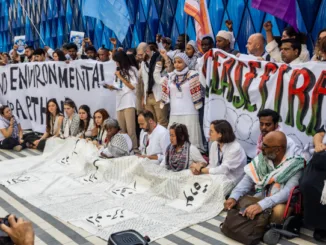
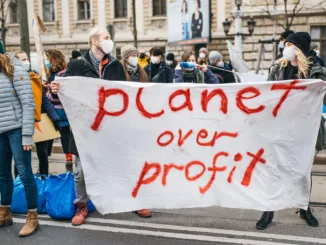
Be the first to comment